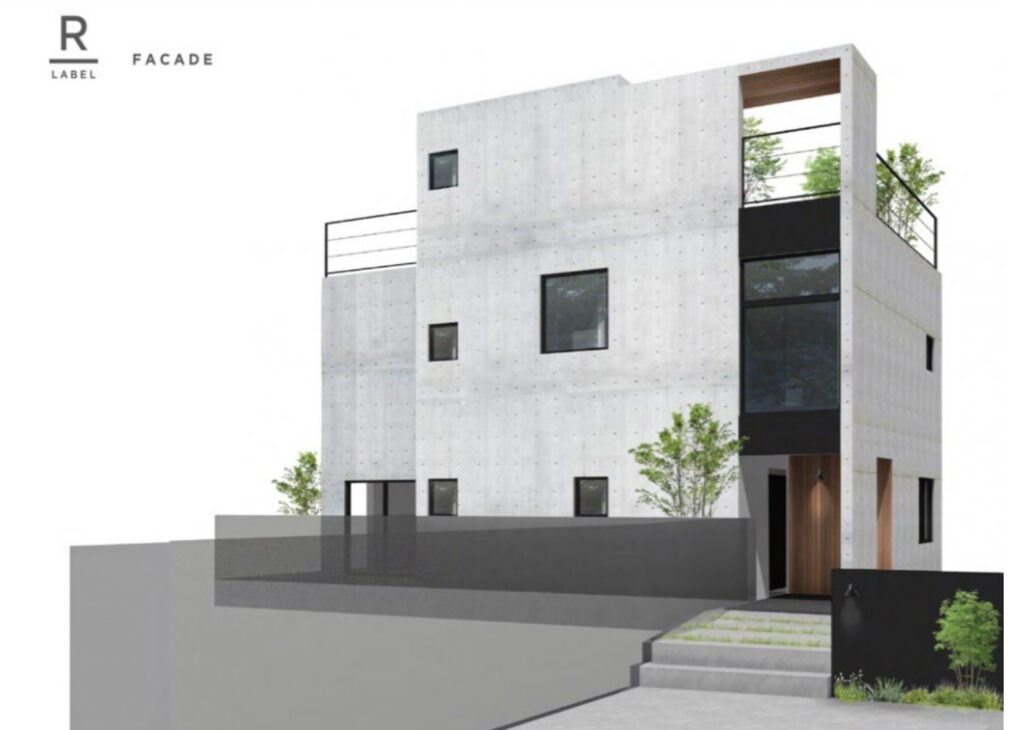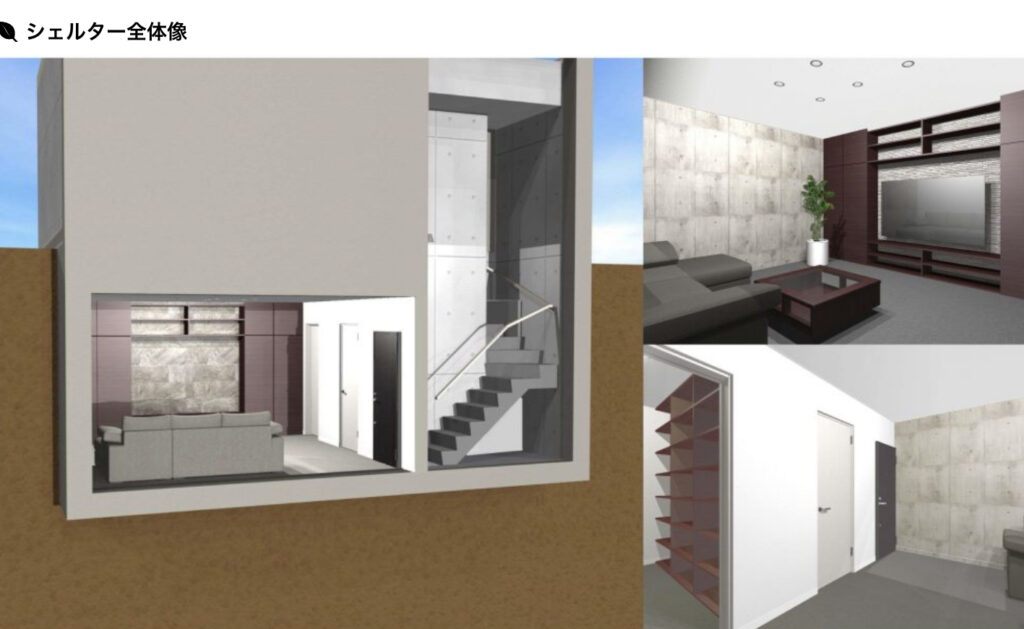東京都において、シェルター付きの住宅が注目されています。北朝鮮のミサイル発射やロシアのウクライナ侵攻を受け、シェルターの必要性に対する国内での関心が高まっているのです。東京都と周辺には数多くの自衛隊基地が存在しています。千葉県、神奈川県、埼玉県からも問い合わせが増えています。
シェルター普及率の国際比較(内閣官房調べ)
| 国名 | 核シェルター普及率 |
|---|---|
| 韓国 | 約331% |
| スイス | 約100% |
| フィンランド | 約86% |
| スウェーデン | 約66% |
| アメリカ | 政府未確認 |
| シンガポール | 非公開 |
| イギリス、フランス、ドイツ、イタリア、カナダ | 政府未確認 |
| 日本(シェルターになり得る構造物) | 139.7% |
| 日本(うち地下活用) | 4.7% |
上記の表は、各国のシェルター普及率を示しています。日本は139.7%、地下については4.7%とありますが、この数値はシェルターとして使える構造物を示しているものです。確実なシェルターにするには、様々な設備が必要になります。同時に日本国民の防衛・避難に対する意識が低いため、まずは意識改革を徹底して、シェルターの知識も習得しなければなりません。意識の差は他国と比較して大きな差があると言えるでしょう。韓国では地下鉄の駅をシェルター化する取り組みを行なっているため、このような高い数値になっています。外出先では公共施設にシェルターがあると安心ですが、自宅に設置することで更に安心感が高まります。
>>政府の動き
日本政府は有事に備え、自衛隊基地や地下鉄の駅をシェルター化することを発表しています。これにより、国民の安全確保に向けた一歩が踏み出されています。政府は自衛隊基地内のシェルター設置並びに、シェルター建築の基準を検討し始めました。
>>核シェルターの建設方法
核シェルターは主にRC造(鉄筋コンクリート造)で作られ、堅固な構造と放射線防護を提供します。これにより、核攻撃のみならず、通常兵器の爆撃からも十分に身を守ることが可能です。核シェルターまでの性能を求めない場合は、通常の地下シェルターを推奨します。核シェルターは放射線物質からも身を守りますが、あくまで核ミサイルが使用された場合です。可能性が高いのは、通常兵器の使用です。この場合は、地下シェルターで十分です。核シェルターと通常の地下シェルターの価格差は、防爆扉と空気のろ過装置ですが、これだけでも、500万円から広さによっては、2000万円の差が出ます。核シェルターと通常の地下シェルター、どちらが良いかは、悩ましいところですが、ご予算に余裕があれば、核シェルターを作ることで気持ち的には安心が高まります。そうでなくても地下シェルターがあるだけで、大きな安心感を得られることは間違いありません。
>> 新築住宅としての検討
新築をお考えの方は、堅牢な構造物であるRC住宅を推奨します。一定の壁厚や鉄筋量を増したRC住宅にすることで、シェルターが完成します。希望があれば「核シェルター」の設置を検討することも可能です。特に東京都のような都市部では、ミサイルやドローン攻撃だけでなく、大地震による火災発生リスクが多く、近隣火災から身を守るためにもRC住宅がお勧めです。内閣官房が検討しているほど日本の危機管理は重要視され始めました。シェルター、核シェルター付き住宅は大袈裟でなく、今後は重要な選択肢になるでしょう。


>>害対策としての検討
首都直下型地震の発生が恐れられれいます。家屋の倒壊による圧死は絶対に撲滅すべきだと弊社は考えています。また、2024年1月1日に発生してしまった能登半島地震では、街全体が火災で消失しました。原因は古い木造家屋が密集していたためですが、仮にあの中に新基準の木造住宅があっても、確実に燃えて消失します。唯一残るのはRC住宅でした。しかし、RC住宅でも窓などの開口部は消失しています。住宅密集地の場合、理想は中庭側の壁面に大きな窓を設置して、隣接する壁面には小さな窓を設置、その小さな窓には火災発生時に耐火材を施したパネルを室内から蓋するなど工夫すると良いです。そして、地下シェルターがあれば、一時的に地下へ避難すると安全です。
核シェルターや地下シェルターは、普段は防音ルームとして多目的利用が可能です。有事だけを考えるのではなく、例えばシアタールームを作る流れで、ついでにシェルター化するという考え方が良いのかも知れません。
The Growing Importance of Homes with Shelters in Tokyo
In Tokyo, homes equipped with shelters are gaining increasing attention. This heightened interest is driven by global geopolitical tensions, such as North Korea’s missile launches and Russia’s invasion of Ukraine. Numerous Japan Self-Defense Forces (JSDF) bases are located in and around the Tokyo area, and inquiries are rising from neighboring prefectures including Chiba, Kanagawa, and Saitama.
| Country | Nuclear Shelter Coverage Rate |
|---|---|
| South Korea | Approx. 331% |
| Switzerland | Approx. 100% |
| Finland | Approx. 86% |
| Sweden | Approx. 66% |
| United States | Not confirmed by government |
| Singapore | Not disclosed |
| UK, France, Germany, Italy, Canada | Not confirmed by government |
| Japan (structures that could serve as shelters) | 139.7% |
| Japan (of which underground usage) | 4.7% |
The chart above compares the shelter coverage rates of various countries. While Japan reports 139.7% coverage and 4.7% for underground facilities, these figures reflect the number of structures that could potentially serve as shelters. To be fully functional as actual shelters, additional equipment and modifications are necessary. Moreover, public awareness in Japan regarding defense and evacuation is relatively low, making mindset reform and public education essential. In contrast, countries like South Korea have converted subway stations into shelters, contributing to their high shelter coverage rate. While having shelters in public spaces offers peace of mind when out and about, the presence of a shelter within one’s own home provides even greater reassurance.
>> Government Initiatives
The Japanese government has announced plans to convert JSDF bases and subway stations into shelters in preparation for potential emergencies. This marks a crucial step toward ensuring national safety. The government has also begun considering standards for shelter construction and installation within military facilities.
>> How Nuclear Shelters Are Built
Nuclear shelters are typically constructed from reinforced concrete (RC), offering strong structural integrity and radiation protection. These shelters are designed not only to protect against nuclear attacks but also conventional bombings. If full-scale nuclear protection is not a priority, a standard underground shelter may suffice. While nuclear shelters provide defense against radioactive substances, this is primarily in the event of nuclear missile use—a scenario less likely than conventional warfare. In such cases, a standard underground shelter offers adequate protection.
The cost difference between a nuclear and a standard underground shelter primarily stems from blast-resistant doors and air filtration systems. This can result in a price gap ranging from 5 million to 20 million yen depending on the size. Choosing between the two depends on your budget, but a nuclear shelter offers greater psychological comfort. That said, even a regular underground shelter can provide a significant sense of security.
>> Considering a Shelter in New Homes
If you’re planning to build a new home, we recommend reinforced concrete (RC) construction for its resilience. By increasing wall thickness and the amount of reinforcing steel, you can effectively create a residential shelter. If desired, the inclusion of a nuclear shelter can also be explored.
In densely populated urban areas like Tokyo, the threat isn’t just missiles or drone attacks but also the risk of widespread fires triggered by major earthquakes. RC homes are especially suitable in such contexts, offering better protection from neighboring fires. The fact that Japan’s Cabinet Secretariat is actively discussing these measures shows how seriously the government is now taking crisis preparedness. Far from being an overreaction, homes equipped with shelters or nuclear shelters are rapidly becoming a rational and important choice.
>> A Countermeasure Against Natural Disasters
There is growing concern over the risk of a major earthquake striking directly beneath the Tokyo metropolitan area. Our company firmly believes that deaths from house collapses should be entirely preventable.
The Noto Peninsula earthquake on January 1, 2024, resulted in the destruction of entire towns by fire. This was due to the dense clustering of old wooden houses. Even if some new-code wooden homes were present in that area, they would likely have burned down as well. The only structures that remained were reinforced concrete houses. However, even those lost their windows and other openings.
In dense residential areas, the ideal design includes large windows on inner courtyard-facing walls and small windows on adjacent exterior walls. These smaller windows can be protected with interior fire-resistant panels in case of fire. An underground shelter also allows residents to evacuate temporarily to safety during such emergencies.
Nuclear and underground shelters can also serve as soundproof multipurpose rooms in daily life. Rather than viewing them solely as wartime facilities, they can be designed as theater rooms or hobby spaces—with the added benefit of being emergency shelters. This multipurpose approach may be the most practical and appealing option for many homeowners.
